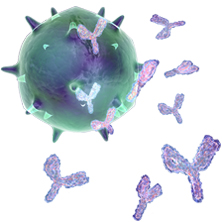Binter C, Khol-Parisini A, Gerner W, Schäfer K, Hulan HW, Saalmüller A, Zentek J Archives of Animal Nutrition, 2011 ABSTRACT: Fatty acids are essential for immune cell function. Maternal dietary fatty acid supply influences body fat composition of their offspring. As a first step to study immunonutritional interactions at an early age of pigs, four… Read more »

This system includes the lymph nodes, white blood cells, lymphatic vessels, thymus gland, bone marrow, spleen and leukocytes. Common disorders include anything with bacterial, viral or fungal origins, leukemia, allergic reactions and autoimmune diseases like lupus or rheumatoid arthritis.
Effects of Rosmarinus officinalis L. essential oils supplementation on digestion, colostrum production of dairy ewes and lamb mortality and growth
Smeti S, Joy M, Hajji H, Alabart JL, Muñoz F, Mahouachi M, Atti N Animal science journal = Nihon chikusan Gakkaiho, 2015 ABSTRACT: The aim of this study was to evaluate the effect of rosemary essential oils (REO) and the forage nature on ewes’ performances, immune response and lambs’ growth and mortality. Forty-eight dairy ewes… Read more »
Patch Testing with Main Sensitizers Does Not Detect All Cases of Contact Allergy to Oxidized Lavender Oil
Hagvall L, Christensson JB Acta dermato-venereologica, 2016 ABSTRACT: Lavender oil is an essential oil obtained from lavender (Lavendula angustifolia). The main components linalool and linalyl acetate have been shown to autoxidize in contact with oxygen in the air, forming sensitizing hydroperoxides. Patients with suspected allergic contact dermatitis were consecutively patch-tested with oxidized lavender oil 6%… Read more »
Chemical composition and in vitro evaluation of antioxidant, antimicrobial, cytotoxicity and anti-acetylcholinesterase properties of Tunisian Origanum majorana L. essential oil
Hajlaoui H, Mighri H, Aouni M, Gharsallah N, Kadri A Microbial pathogenesis, 2016 ABSTRACT: This study investigated the chemical composition and evaluated the antioxidant, antimicrobial, cytotoxic and anti-acetylcholinesterase properties of Tunisian Origanum majorana essential oil. The findings showed that the oil exhibited high activity, particularly in terms of reducing power and β-Carotene bleaching, inducing higher… Read more »
The role of structure and molecular properties of terpenoids in determining their antimicrobial activity
Griffin SG, Wyllie SG, Julie L, Markham, Leach DN Flavour and Fragrance Journal, 1999 ABSTRACT: The minimum inhibitory concentrations (MIC) of 60 terpenoids against Pseudomonas aeruginosa, Escherichia coli, Staphylococcus aureus and Candida albicans have been determined. Hierarchical cluster analysis was used to group the compounds into five groups according to their activity patterns against the four microorganisms. K-Means… Read more »
Cinnamon (Cinnamomum sp.) inclusion in diets for Nile tilapia submitted to acute hypoxic stress
Welliene M. dos Santos, , Túlio S. de Brito, Samuel de A. Prado, Camila G. de Oliveira, Andréia C. De Paula, Daniela C. de Melo, Paula A.P. Ribeiro Fish & Shellfish Immunology, 2016 ABSTRACT: The aim of this study was to evaluate the possible effects of diets supplemented with probiotics and different cinnamon levels (powder… Read more »
Oregano Essential Oil Improves Intestinal Morphology and Expression of Tight Junction Proteins Associated with Modulation of Selected Intestinal Bacteria and Immune Status in a Pig Model
Yi Zou, Quanhang Xiang, Jun Wang, Jian Peng, Hongkui Wei BioMed Research International, 2016 ABSTRACT: Oregano essential oil (OEO) has long been used to improve the health of animals, particularly the health of intestine, which is generally attributed to its antimicrobial and anti-inflammatory effects. However, how OEO acts in the intestine of pig is still… Read more »
Antibacterial and antifungal activities of thymol: A brief review of the literature
Marchesea A, Orhanb IE, Dagliac M, Barbieria R, Lorenzoc AD, Nabavid SF, Gortzie O, Izadif M, Nabavid SM Food Chemistry, 2016 ABSTRACT: Thymol (2-isopropyl-5-methylphenol) is the main monoterpene phenol occurring in essential oils isolated from plants belonging to the Lamiaceae family (Thymus, Ocimum,Origanum, and Monarda genera), and other plants such as those belonging to the… Read more »
Functionalities of conjugated compounds of γ-aminobutyric acid with salicylaldehyde or cinnamaldehyde
Liu TT, Tseng YW, Yang TS Food chemistry, 2016 ABSTRACT: Aldehydes or ketones can react with amino compounds to form Schiff base adducts, which have been widely studied and shown to exhibit antimicrobial, antioxidant or antiviral activity. Salicylaldehyde (SA) and cinnamaldehyde (CA) are components of plant essential oils. γ-Aminobutyric acid (GA) is an important substance… Read more »
Chemistry and Pharmacology of Citrus sinensis
Favela-Hernández JM, González-Santiago O, Ramírez-Cabrera MA, Esquivel-Ferriño PC, Camacho-Corona Mdel R Molecules, 2016 ABSTRACT: Presently the search for new drugs from natural resources is of growing interest to the pharmaceutical industry. Natural products have been the source of new drugs since ancient times. Plants are a good source of secondary metabolites which have been found… Read more »
